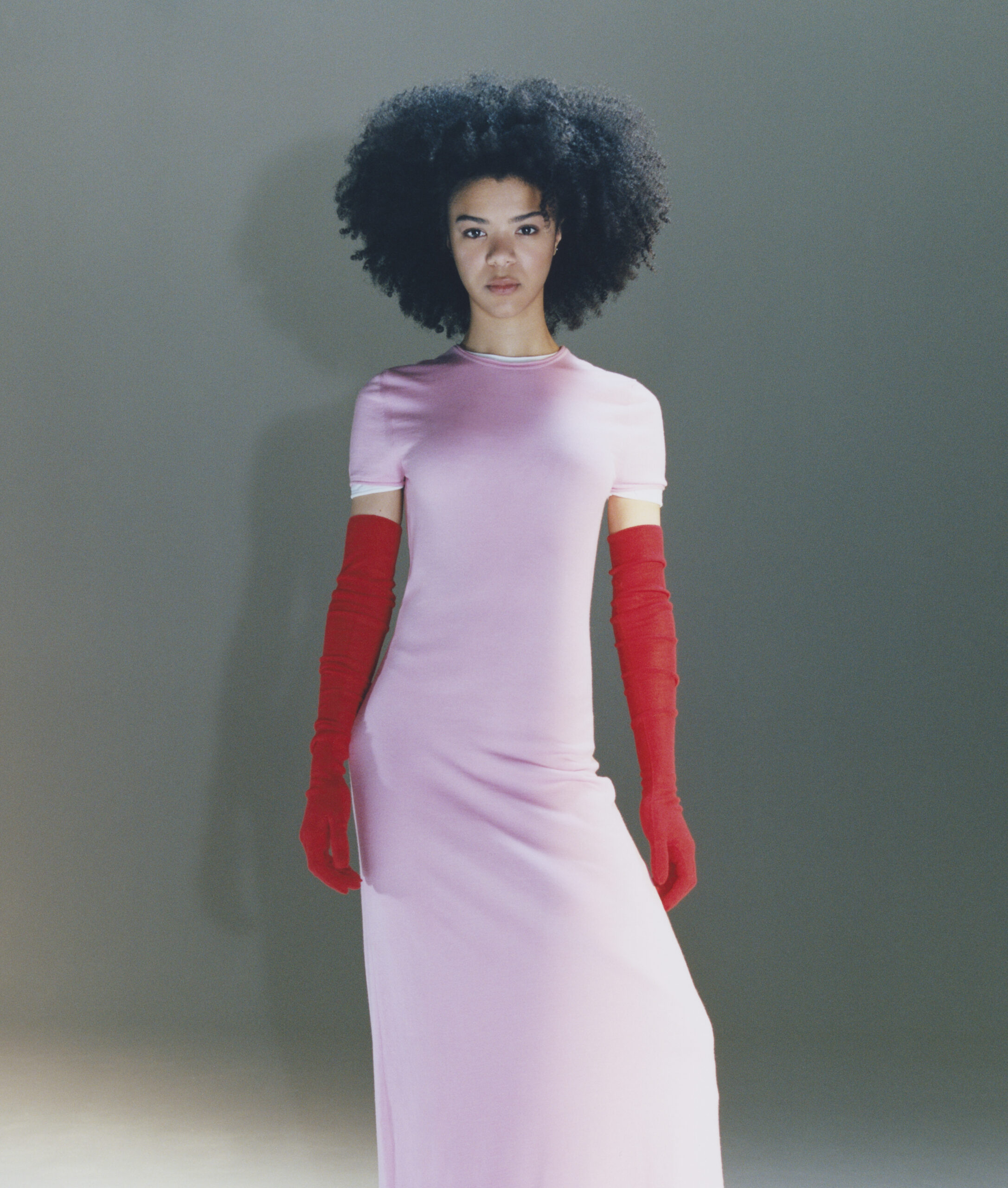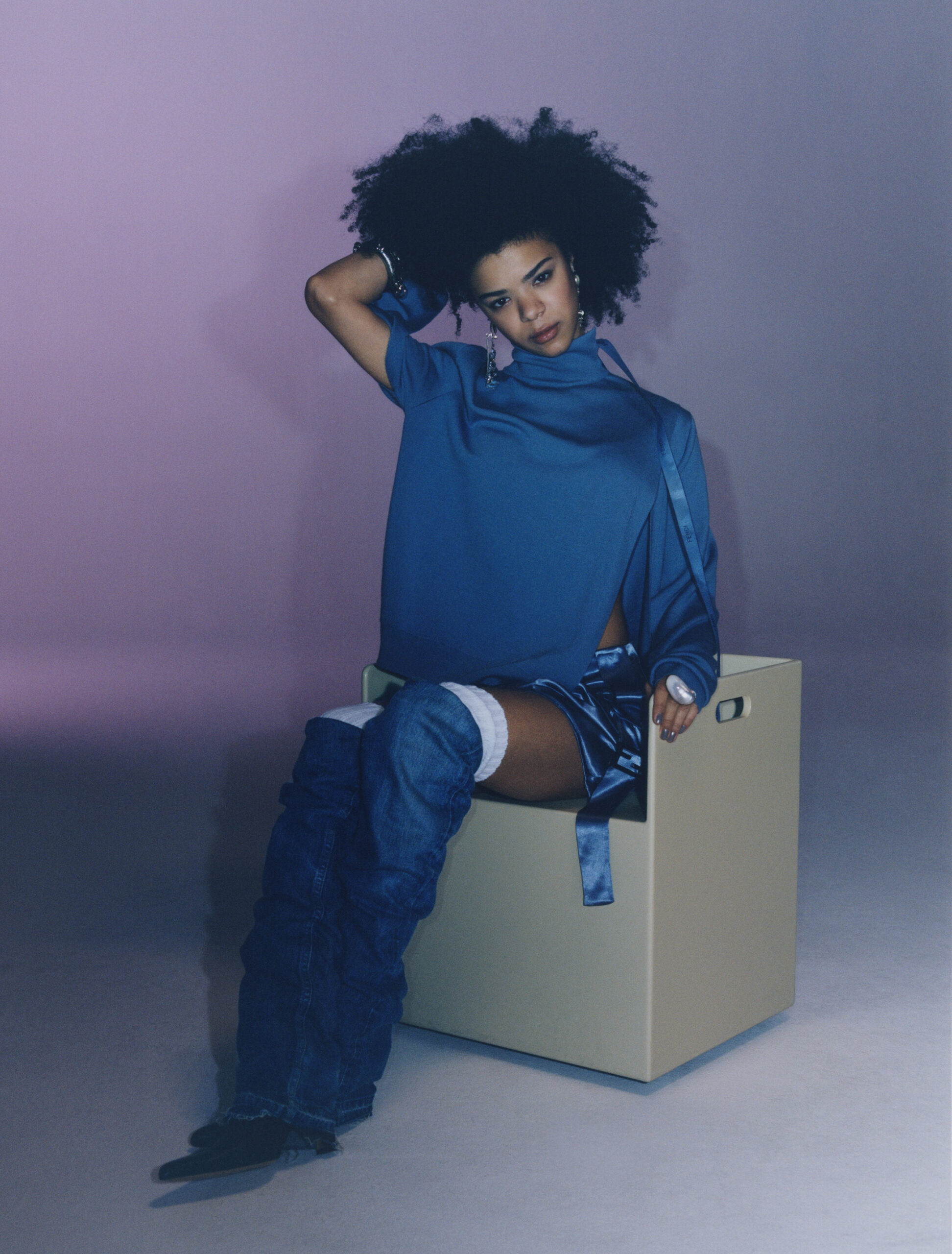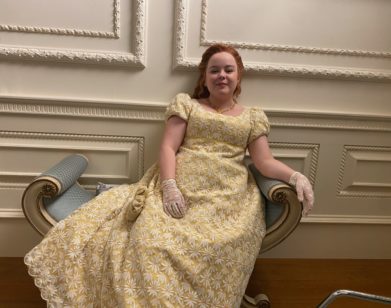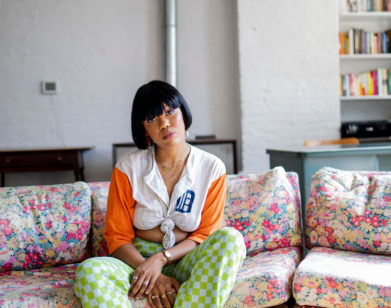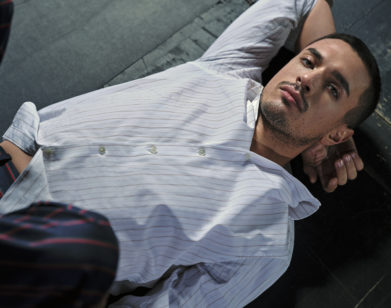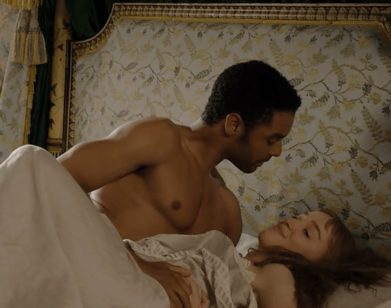SHONDALAND
India Amarteifio on Claustrophobic Corsets and Queen Charlotte
Like any good Brit, India Amarteifio made her West End debut at 10-years-old and is now playing a royal on television. (By which I mean, Netflix). That there’s only an 11-year gap between those career milestones is just half the story, as the fresh-faced 21-year-old is playing the titular lead in Shonda Rhimes’ latest Queen Charlotte, a spin-off of her massively popular Bridgerton series. The contested legend, for the uninitiated, is that the German-born queen of 1761 was possibly biracial, a theory Rhimes has taken and run with, giving us another of her signature blends of gossipy bureaucracy and wine-glass-clutching sex scenes, this time with some “fuck monarchical propriety” cheek.
The spirited Amarteifio fits the bill perfectly, and not just because she is of Ghanaian and German descent herself. She speaks with a matter-of-factness that still allows for winking fun (again: a British actor) and always looks like she knows something you don’t. All to say she has the self-assured comportment which befits a royal, and the mischievous glint in her eye that promises a rising career to watch. Prepping to begin the Queen Charlotte press tour in earnest, Amarteifio Zoomed me from Los Angeles—her first time out of England—to talk about claustrophobic corsets, playing a Black Royal, and entering the United States of Shondaland.
———
INDIA AMARTEIFIO: Hi, Juan.
JUAN RAMÍREZ: Hi. How are you?
AMARTEIFIO: I’m so sorry that I’m a bit late. I got stuck in the lift.
RAMÍREZ: Oh, god. Hopefully you’re not claustrophobic.
AMARTEIFIO: All good, all fine.
RAMÍREZ: I guess you can’t be claustrophobic in the outfits you’re wearing in the show, huh?
AMARTEIFIO: Well, you can be because I was, but there’s nothing I can do about it.
RAMÍREZ: Tell me more.
AMARTEIFIO: You’re completely kind of encased in these dresses and you’re also in a corset, so you’ve got something restricting you this way and that way, so there’s no breathing room and your organs kind of rearrange themselves a little bit.
RAMÍREZ: Do you have a time limit before you have to take a break?
AMARTEIFIO: I mean, I would prefer not to wear it at all. I would say every two hours I take it off just to actually have a breath.
RAMÍREZ: Right. Is it heavy?
AMARTEIFIO: Very. It changed my figure completely. I was in it sometimes 10 hours a day and it’s a real corset, so it’s a lot. I was expecting to do a job, I wasn’t expecting to come out with different body shape.
RAMÍREZ: What about the wigs?
AMARTEIFIO: Really heavy. And Golda, who plays the older Queen Charlotte, hers was so heavy, she had to wear a neck brace on set to make sure she didn’t topple over. Serious business.
RAMÍREZ: Oh my god. Did you think about this before you came on board?
AMARTEIFIO: Not at all. I just thought it would look really beautiful, and it would look authentic. But I didn’t think that our costume designer, Lyn [Paolo], would make them authentic. But it actually makes my performance better because I become a different person. I don’t usually wear a corset. I have to hold my body in a certain way, I have to walk a different way. So it was kind of imperative in being able to create Charlotte.
RAMÍREZ: Are you the type of actor that feels the character once they step into the costume?
AMARTEIFIO: For sure, more so ever than on this job. And I think that’s probably why, because it was the first time I wore clothes that were so different to what I would usually wear. I’m a sneakers, big hoodie kind of girl. So to wear tiny, little heels and all this pretty makeup, I just didn’t recognize myself. I completely disassociated and detached and was able to create a completely different person. So yeah, it was really helpful.
RAMÍREZ: Are you sort of heading straight into Bridgerton press universe?
AMARTEIFIO: Yeah, it’s like the journey now. I’ve been really anxious for about the last three months because I knew that this was coming, but I knew that I had to wait three months for it to come. And now that it’s here, we can gear up and get ready to go do it. It’s one of the best parts of the job, getting to travel, and I’d never been to L.A. before doing this job. I’d never been out of Europe before doing this job. So it’s a lot of firsts.
RAMÍREZ: How is entering Shondaland? It’s such an empire.
AMARTEIFIO: Huge. I felt it. I didn’t feel it meeting her and I didn’t feel it meeting my director because they’re so low-key and they’re super chill. But coming away from it and being on the press part and seeing all the marketing that’s going out and these billboards with mine and Corey’s [Mylchreest] face all over it? I didn’t realize the impact Shonda had on our industry. So I felt a massive like, “Whoa, this is different. This is a different job and a different beast to tackle.”
RAMÍREZ: What’s her presence like over in the UK?
AMARTEIFIO: I think for a lot of actors she doesn’t feel real and I think that’s just because America doesn’t feel real. All of our films are American and we’ve got a very romanticized vision of everyone in the States and what life is like in the States, because it’s in a movie, and we see it through rose-tinted glasses. Everyone watched Scandal and Grey’s and How to Get Away with Murder, but I think a lot of actors didn’t really consider themselves to ever be in that realm because she’s so major. It’s a completely different world. I never grew up thinking, “I’m going to be in her show.”
RAMÍREZ: Did that start to change in your head when Bridgerton came out?
AMARTEIFIO: Yeah, completely. And also the genre of period drama changed for me. It wasn’t something I wanted to be in because historically, people who looked like me were not shown in positions of great authority or roles that were reflected in a positive way. It’s people in acts of service. So it wasn’t anything that I had real interest in. Then when Bridgerton kind of burst onto our scenes and Shonda created this bountiful world of diverse society in 17-whatever, I was like, “Yeah, I’m sold.” It’s such a good way of introducing people to genres that they almost weren’t allowed to be in. We’ve never claimed that Queen Charlotte’s a documentary, we’ve never claimed Bridgerton‘s a documentary. Why can’t we put these people into these roles? It’s film. It’s supposed to be entertainment.
RAMÍREZ: I’ve always felt that the UK is a bit ahead of the States with more colorblind casting, but do you feel like that’s not entirely the case?
AMARTEIFIO: I think since I’ve been in the industry, we’ve definitely come a long way. Before, people of different ethnic backgrounds were not offered leading roles. In British television, it was usually the sidekick or the best friend. I used to play a lot of daughters. So the roles are now becoming a lot more complex, but I feel like we’ve still got a long way to go. I do agree that maybe our shows are not necessarily focused on race. They have characters who are from different backgrounds, but the sole topic isn’t their existence as said Black person or Asian person. But we’ve still got mountains to climb.
RAMÍREZ: I was researching Queen Charlotte and her own ancestry is sometimes contested. Did you ever talk to the writers about whether this was a statement on who she actually was, or a thought experiment?
AMARTEIFIO: Not really, probably because I’d seen Bridgerton and I’d seen Golda. I was playing the younger version of another person, so I had to look like that person. I just really like Shonda’s idea of, “What if we go down this route of Queen Charlotte being Black and we take that as fact and we use that?” And as I said, it’s not documentary, it’s a fantastical fantasy land, so we can do whatever we want. But I applaud Shonda to the highest degree on her wanting to make that happen because I think a lot of screenwriters would probably be scared to rock the boat with people that want everything to look historically accurate. And she was like, “No, I want to do something a bit different.”
RAMÍREZ: On this side of the Atlantic, I sometimes forget how many people are obsessed with the royals. How did you feel wading into that knowing how heated people get about all this?
AMARTEIFIO: From the beginning they drilled into us that they were not wanting to do a documentary. Queen Charlotte and King George existed as historical figures, but we were taking two real people and creating a storyline that was not real. And there are flickers of reality and things we know from accounts of people around them. But we’re not claiming it to be historically accurate, so the pressure was off on that front.
RAMÍREZ: What’s your own history with the Royals?
AMARTEIFIO: I mean, I’m very much a Brit and the Queen is all over my bank notes, so I saw her every day. But I guess my connection was more to the fact that they lived in Buckingham Palace and I would drive down Pall Mall after I had finished my shows in the West End in the evening and say, “Oh, the Queen’s in.” That’s probably my only connection with them.
RAMÍREZ: How did you prepare to become Charlotte?
AMARTEIFIO: I read a really good book by an author called Janice Hadlow. I went to Kew Gardens where George and Charlotte lived. I did as much research as I thought was needed because at the end of the day, it’s Shonda’s retelling of history and she didn’t want me to get bogged down on the facts because she’s creating a completely different world. Research is crucial and every actor should do as much research into their role as possible.
RAMÍREZ: As an outsider to this world, I can’t watch the show without thinking of another mixed-race foreigner who entered the Crown, Meghan Markle. Did that play into your thoughts on the role?
AMARTEIFIO: Not at all. It’s a fantasy land. I think the only thing that I could draw comparisons with is the fact that we’re still having the same conversations now that we were 400 years ago. Hopefully the show will aid change rather than just talking about things and nothing being done.
RAMÍREZ: As a Brit, do you feel any sense of reclamation in playing a queen?
AMARTEIFIO: It’s just something I never thought I would be able to do. It feels very surreal and I think it will be really good for young Black girls to see themselves represented in this way because it’s not often done, if at all. So to be in any way involved in creating representation on that front is really important to me.
RAMÍREZ: How was it drawing that line between who you’re going to play and who your character’s going to wind up being?
AMARTEIFIO: Shonda and Tom [Verica] were very clear at the beginning of filming and prep to not have me emulate any of Golda’s performance. They purposefully were like, “Please don’t watch any of her stuff,” and I’d already seen it. So I think casting found that that me and Golda have very similar traits and our expressions are quite similar. We met up for coffee quite early on and had a general chat about Golda’s understanding of where young Queen Charlotte came from, and then my understanding. But it felt really nice to be able to take this role as my own and to have complete creative freedom to do that.
RAMÍREZ: Who is Charlotte to you? How did you find your way into her, emotionally speaking?
AMARTEIFIO: A lot of script annotating. In period dramas, so much is unsaid, it’s in a glance or it’s in a touch. So me looking at the script and trying to figure out what she’s actually saying, what she actually wants, was really important. Working quite closely with Corey, who plays the king, in annotating scripts and creating that relationship also was really important.
RAMÍREZ: Your physical relationship is such a big part of the show.
AMARTEIFIO: What really helped us become comfortable enough to create that physical relationship between Charlotte and George was just me and Corey getting along so well. He’s just the loveliest person ever and is really dedicated to his work, and I am very dedicated as well. We had a mutual respect there and we both really wanted to do justice to the script. On top of that, we have extensive intimacy coordination with Lizzy Talbot and Lucy Fennell, who basically choreograph any moments of touch. You know exactly what you’re doing prior to going on set. It’s just like performing a dance. It’s all very regimented and considered and thought out. But it felt nice to be able to have a collaboration with them and have a say, because myself and Corey know our characters better than anyone. Well, not better than Shonda, but better than anyone on set. So for us to be able to say, “I don’t think Charlotte would do that in this situation,” or, “George might do this instead,” felt really great as actors. I felt very seen and very considered by the rest of my cast and my crew.
RAMÍREZ: How much earlier before you started the shooting did you meet him?
AMARTEIFIO: About two months, we’d met each other. Luckily, we’d been given a month rehearsal period, not just with myself and Corey, but to meet Arsema and to spend time with my director and the rest of the cast and Sam, who plays Brimsley. To get that understanding of who you are going to be working with the next six months was really, really helpful. Then you spend every day with someone on set for six months, you get to know what makes them tick and why they laugh and why they cry.
RAMÍREZ: Now you’ve got a season with Shonda under your belt.
AMARTEIFIO: It’s intense, but in the best way. To be on set every day was a very new skill and I had to learn how to have stamina. It was a big learning experience, but the best that I could have ever had.
RAMÍREZ: I could imagine she’s very detail-oriented. Have you seen her Architectural Digest feature?
AMARTEIFIO: Yes! Amazing. It looks like the set of Bridgerton, literally.
RAMÍREZ: Did you ever ask her about her pull to British Royals and this period?
AMARTEIFIO: No, I never did. But hearing interviews, she’s always been fascinated by Charlotte and the fact that she could have Black connections. And Charlotte’s obviously a big figure over here in the States, Charlottesville.
RAMÍREZ: Have you connected with anyone in the Bridgerton universe?
AMARTEIFIO: I met Claudia Jessie, who plays Eloise. She was delightful and basically just said, “Yeah, if you need me, call me.” And I met Charithra, who plays one of the Sharma sisters. I met Nicola, who plays Penelope, obviously. Everyone has just been delightful. I feel like we’re all kind of bonded in this weird way of no one else understanding what we’re going through, so it feels nice that there are people older and wiser than me that have already been through it.
RAMÍREZ: Great. Well I’m glad you have that Bridgerton family backing you up.
AMARTEIFIO: I am, as well.
RAMÍREZ: India, this has been lovely. I hope you have a great stay in the States.
AMARTEIFIO: Thank you very much. Lovely to meet you.
———
Hair: Nicola Harrowell using KEVIN.MURPHY at Premier
Makeup: Lauren Reynolds at Bryant Artists
Nails: Liia Zotova at Future Rep
Set Design: Rachel Schofield Owen
Makeup Assistant: Rafael Garcia Sanchez at Soft Tissue Studio
Photo Assistants: Federico Covarelli Federici and Joshua Onabowu
Styling Assistants: Lily Goddard and Piper Dudley
Special Thanks: Arlington Road Studio

